 | –≠–ª–µ–∫—Ç—Ä–æ–Ω–Ω—ã–π –∫–æ–º–ø–æ–Ω–µ–Ω—Ç: STA575 | –°–∫–∞—á–∞—Ç—å:  PDF PDF  ZIP ZIP |

1/20
STA575
July 2003
s
MONOCHIP BRIDGE STEREO AMPLIFIER
ON BASH
Æ
ARCHITECTURE
s
80+80W OUTPUT POWER @ R
L
= 4/8
,
THD = 0.5%
s
100+100W OUTPUT POWER @ R
L
= 4/8
,
THD = 10%
s
HIGH DYNAMIC PREAMPLIFIER INPUT
STAGES
s
EXTERNAL PROGRAMMABLE FEEDBACK
TYPE COMPRESSORS
s
AC COUPLED INPUT TO CLASS AB BRIDGE
OUTPUT AMPLIFIER
s
PRECISION RECTIFIERS TO DRIVE THE
DIGITAL CONVERTER
s
ON-OFF SEQUENCE/ TIMER WITH MUTE
AND STANDBY
s
PROPORTIONAL OVER POWER OUTPUT
CURRENT TO LIMIT THE DIGITAL
CONVERTER
s
ABSOLUTE POWER BRIDGE OUTPUT
TRANSISTOR POWER PROTECTION
s
ABSOLUTE OUTPUT CURRENT LIMIT
s
INTEGRATED THERMAL PROTECTION
s
POWER SUPPLY OVER VOLTAGE
PROTECTION
s
FLEXIWATT POWER PACKAGE WITH 27 PIN
s
BASHÆ LICENCE REQUIRED
DESCRIPTION
The STA575 is a fully integrated power module de-
signed to implement a BASHÆ amplifier when used
in conjunction with STABP01 digital processor.
FLEXIWATT27
100+100W STEREO
POWER AMPLIFIER
BLOCK DIAGRAM
ABSOLUTE
VALUE
BLOCK
OUTPUT BRIDGE
PEAK/2
DETECTOR
VOLTAGE
PROTECTION
SOA
DETECTOR
TURN-
ON/OFF
SEQUENCE
THERMAL
PROTECTION
PEAK/2
DETECTOR
COMPRESSOR
COMPRESSOR
G
+2
-1
G
+
-
V/l
V/l
S1
Ict
Ict
ABSOLUTE
VALUE
BLOCK
+
-
S1
OUTPUT BRIDGE
CD-2
CD+2
STBY/MUTE
PROT.
CD+
CD-1
OUT1-
OUT1+
CD+1
IN_PRE1
ATT_REL1
TRK_OUT
THRESH
ATT_REL2
IN_PRE2
PWR_INP1
TRK_1
OUT_ PRE1
-VS
GND
+VS
PWR_INP2
D01AU1263
TRK_2
OUT_ PRE2
OUT2-
OUT2+
+2
-1
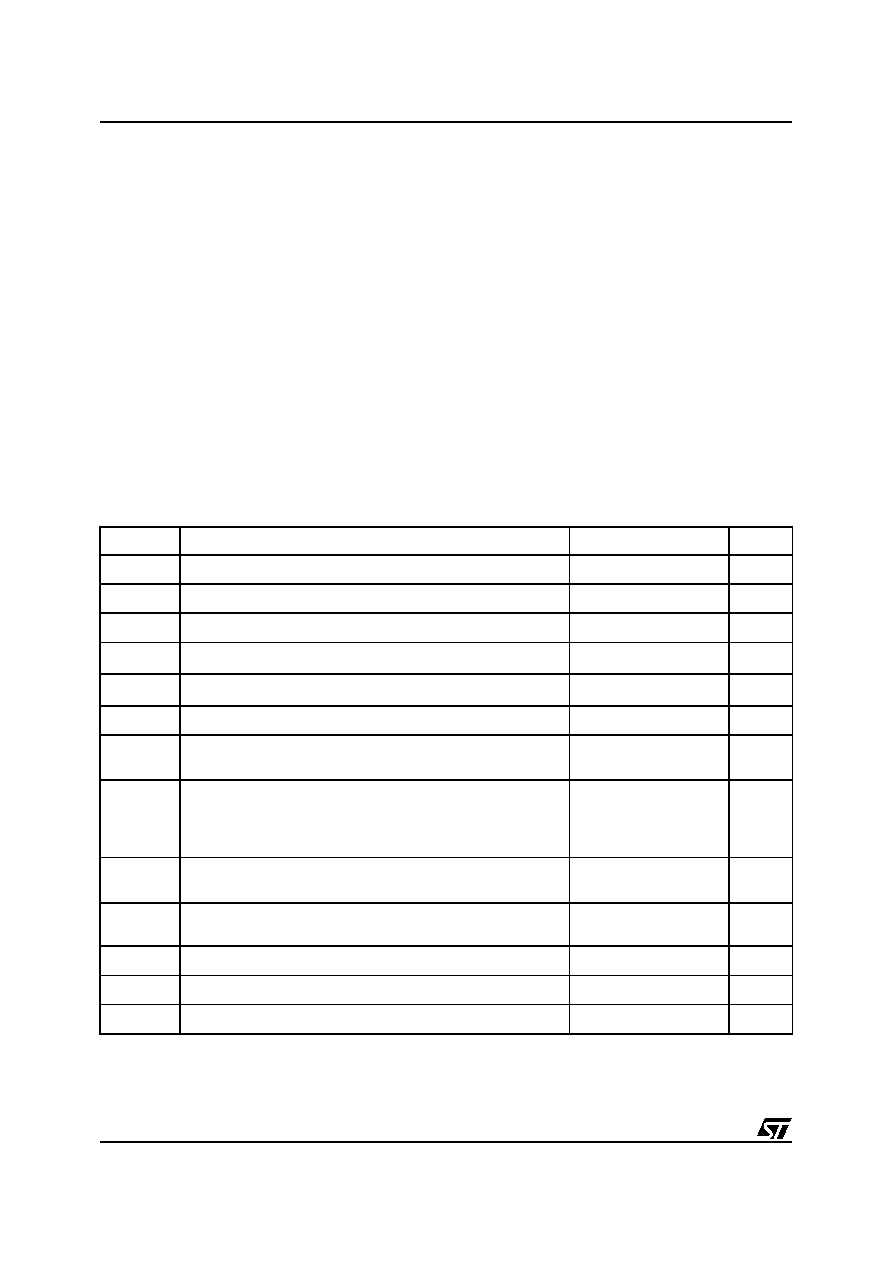
STA575
2/20
DESCRIPTION (continued)
Notice that normally only one Digital Converter is needed to supply a stereo or multi-channel amplifier system,
therefore most of the functions implemented in the circuit have summing outputs
The signal circuits are biased by fixed negative and positive voltages referred to Ground. Instead the final stag-
es of the output amplifiers are supplied by two external voltages that are following the audio signal . In this way
the headroom for the output transistors is kept at minimum level to obtain a high efficiency power amplifier.
The Compressor circuits, one for each channel, performs a particular transfer behavior to avoid the dynamic
restriction that an adaptive system like this requires. To have a high flexibility the attack / release time and the
threshold levels are externally programmable. The tracking signal for the external digital converter is generated
from the Absolute Value block that rectifies the audio signal present at the compressor output. The outputs of
these blocks are decoupled by a diode to permit an easy sum of this signal for the multichannel application. The
output power bridges have a dedicated input pin to perform an AC decoupling to cancel the compressor output
DC offset. The gain of the stage is equal to 4 (+12dB). A sophisticated circuit performs the output transistor pow-
er detector that , with the digital converter, reduces the power supply voltage . Moreover, a maximum current
output limiting and the over temperature sensor have been added to protect the circuit itself. The external volt-
age applied to the STBY/MUTE pin forces the two amplifiers in the proper condition to guarantee a silent turn-
on and turn-off.
ABSOLUTE MAXIMUM RATINGS
Note 1: V
CD-
must not be more negative than -Vs and V
CD+
must not be more positive than +V
S
Note 2: All pins withstand
±
2KV ESD but not pin 11
Symbol
Parameter
Value
Unit
+V
s
Positive supply voltage referred to pin 13 (GND)
30
V
-V
s
Negative supply voltage referred to pin 13 (GND)
-24
V
V
CD+
Positive supply voltage tracking rail referred to pin 13 (GND)
22
V
V
CD+
Positive supply voltage operated to Vs+
(1)
0.3
V
V
CD-
Negative supply voltage referred to -Vs
(1)
-0.3
V
V
CD-
Negative supply voltage tracking rail referred to pin 13 (GND)
-22
V
V
Att_Rel1
V
Att_Rel2
Pin 3, 25 Negative & Positive maximum voltage referred to GND
(pin 13)
-0.5 to +20
V
V
Pwr_Imp1
V
Pwr_Imp2
V
Trk_1
V
Trk_2
Pin 7, 21, 18, 10 Negative & Positive maximum voltage referred to
GND (pin 13)
-20 to +20
V
V
In_pre1
V
In_pre2
Pin 8, 20 Negative & Positive maximum voltage referred to GND
(pin 13)
-0.5 to +0.5
V
V
threshold
Pin 17 Negative & Positive maximum voltage referred to GND (pin
13)
-7 to +0.5
V
I
stb-max
Pin 11 maximum input current (Internal voltage clamp at 5V)
500
µ
A
V
stbymute
Pin 11 negative maximum voltage referred to GND (pin 13)
-0.5
V
I
out
Output current
7.7
A
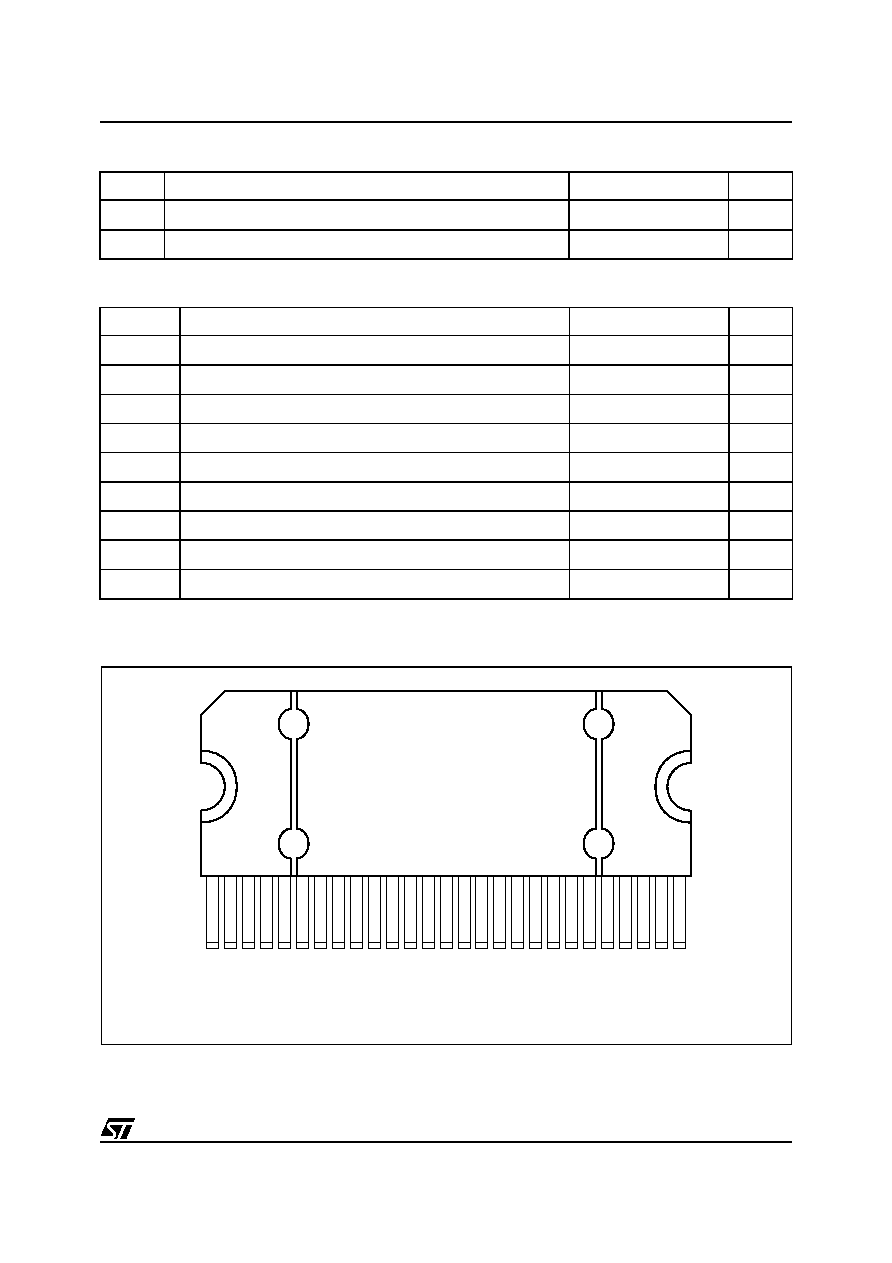
3/20
STA575
THERMAL DATA
OPERATING RANGE
PIN CONNECTION
Note: Slug connected to pins n. 1 and 27
Symbol
Parameter
Value
Unit
T
j
Max Junction temperature
150
∞C
R
th j_case
Thermal Resistance Junction to case
.............................. ..
max
1
∞
C/W
Symbol
Parameter
Value
Unit
+V
s
Positive supply voltage
+20 to +28
V
-V
s
Negative supply voltage
-10 to -23
V
V
s+
Delta positive supply voltage
5V
(Vs+ - VCD+)
10V
V
V
CD+
Positive supply voltage tracking rail
+3 to 20.7
V
V
CD-
Negative supply voltage tracking rail
-20.7 to -3
V
I
in_Max
Current at pin In_Pre1, In_Pre2, related to compressor behaviour
-1 to +1
mA peak
V
trheshold
Voltage at pin Threshold
-5 to 0
V
T
amb
Ambient Temperature Range
0 to 70
∞C
I
sb_max
Pin 11 maximum input current (Internal voltage clmp at 5V)
200
µ
A
D01AU1251
CD-1
-V
S
ATT-REL1
OUT1+
OUT1-
CD+1
PWR_INP1
IN_PRE1
OUT_PRE1
TRK_1
STBY/MUTE
PROTECTION
GND
+V
S
CD+
TRK_OUT
THRESHOLD
TRK_2
OUT_PRE2
IN_PRE2
PWR_INP2
CD+2
OUT2-
OUT2+
ATT_REL2
CD-2
-Vs
1
27

STA575
4/20
PIN FUNCTION
N∞
Name
Description
1
-Vs
Negative Bias Supply
2
CD-1
Channel 1 Time varying tracking rail negative power supply
3
Att_Rel1
Attack release rate for channel 1
4
Out1+
Channel 1 speaker positive output
5
Out1-
Channel 1 speaker negative output
6
CD+1
Channel 1 positive power supply
7
Pwr_Inp1
Input to channel 1 power stage
8
In_pre1
Pre-amp input for channel 1 (virtual ground)
9
Out_pre1
Output channel 1 pre-amp
10
Trk_1
Absolute value block input for channel 1
11
Stby/mute
Standby/mute input voltage control
12
Protection
Protection signal for STABP01 digital processor
13
Gnd
Analog Ground
14
+Vs
Positive Bias Supply
15
CD+
Time varying tracking rail positive power supply
16
Trk_out
Reference output for STABP01 digital processor
17
Threshold
Compressor threshold input
18
Trk_2
Absolute value block input for channel 2
19
Out_pre2
Output channel 2 pre-amp
20
In_pre2
Pre-amp input for channel 2 (virtual ground)
21
Pwr_Inp2
Input to channel 2 power stage
22
CD+2
Channel 2 positive power supply
23
Out2-
Channel 2 speaker negative output
24
Out2+
Channel 2 speaker positive output
25
Att_Rel2
Attack release rate for channel 2
26
CD-2
Channel 2 Time varying tracking rail negative power supply
27
-Vs
Negative Bias Supply

5/20
STA575
ELECTRICAL CHARACTERISTCS (Test Condition: Vs+ = 28V, Vs- = -23V, V
CD+
= 20V, V
CD-
= -20V, R
L
=
8
, external components at the nominal value f = 1KHz, Tamb = 25∞C unless otherwise specified
Symbol
Parameter
Test Condition
Min.
Typ.
Max.
Unit
PREAMPLIFIER AND COMPRESSOR
V
out clamp
Maximum Voltage at Out_pre pin
9
11
13
Vpeak
I
in
Audio input current
0.8
mA
V
control
Voltage at Attack_Release pin
Attenuation = 0dB
Attenuation = 6dB
Attenuation = 26dB
0.35
6
0
0.5
9
0.65
12
V
V
V
VC
omp_
Th
Input voltage range for the
compression
-5
-1
V
Z
th
Input impedance of Threshold pin
100
K
Voffset
Output Offset at Out_pre pin with:
V
CRT
= 0V; Attenuation = 0dB
V
CRT
= 0.5V; Attenuation = 6dB
V
CRT
= 9V; Attenuation = 26dB
-15
-250
-1000
15
250
450
mV
mV
mV
THD
Distortion at Out_pre:
V
CRT
= 0V; Attenuation = 0dB
V
CRT
= 0.5V; Attenuation = 6dB
V
CRT
= 9V; Attenuation = 26dB
0.01
0.1
0.5
2
%
%
%
EN
Noise at Out_pre pin :
V
CRT
= 0V; Attenuation = 0dB
V
CRT
= 0.5V; Attenuation = 6dB
V
CRT
= 9V; Attenuation = 26dB
10
(2)
50
60
µ
V
µ
V
µ
V
I
ct
Attack time current at pin
Attack_release
0.5
1.5
3
mA
1. This value is due to the thermal noise of the external resistors R
r
and R
i
.
TRACKING PARAMETERS
G
trk
Tracking reference voltage gain
13
14
15
V
V
trk_out
Tracking ref. output voltage
0
20
V
I
trk_out
Current capability
5
6
7
mA
Z
trk_in
Input impedance (T
RK1/2
)
1
M
OUTPUT BRIDGE
G
out
Half Output bridge gain
5.5
6
6.5
dB
G
ch
Output bridge differential gain
11
12
13
dB
G
ch
Output bridges gain mismatch
-0.5
0.5
dB
P
out
Continuous Output Power
THD = 0.5%
THD = 10%
75
95
80
100
W
W
THD = 10%; R
L
= 4
; V
CD+
= 16V;
V
CD-
= -16V; V
S+
= 22V; V
S-
= -22V
90
100
W
THD
Total harmonic distortion of the
output bridge
Po = 5W
0.01
0.1
%
f = 20Hz to 20KHz; Po = 50W
0.2
%
V
Off
Output bridge D.C. offset
-70
70
mV
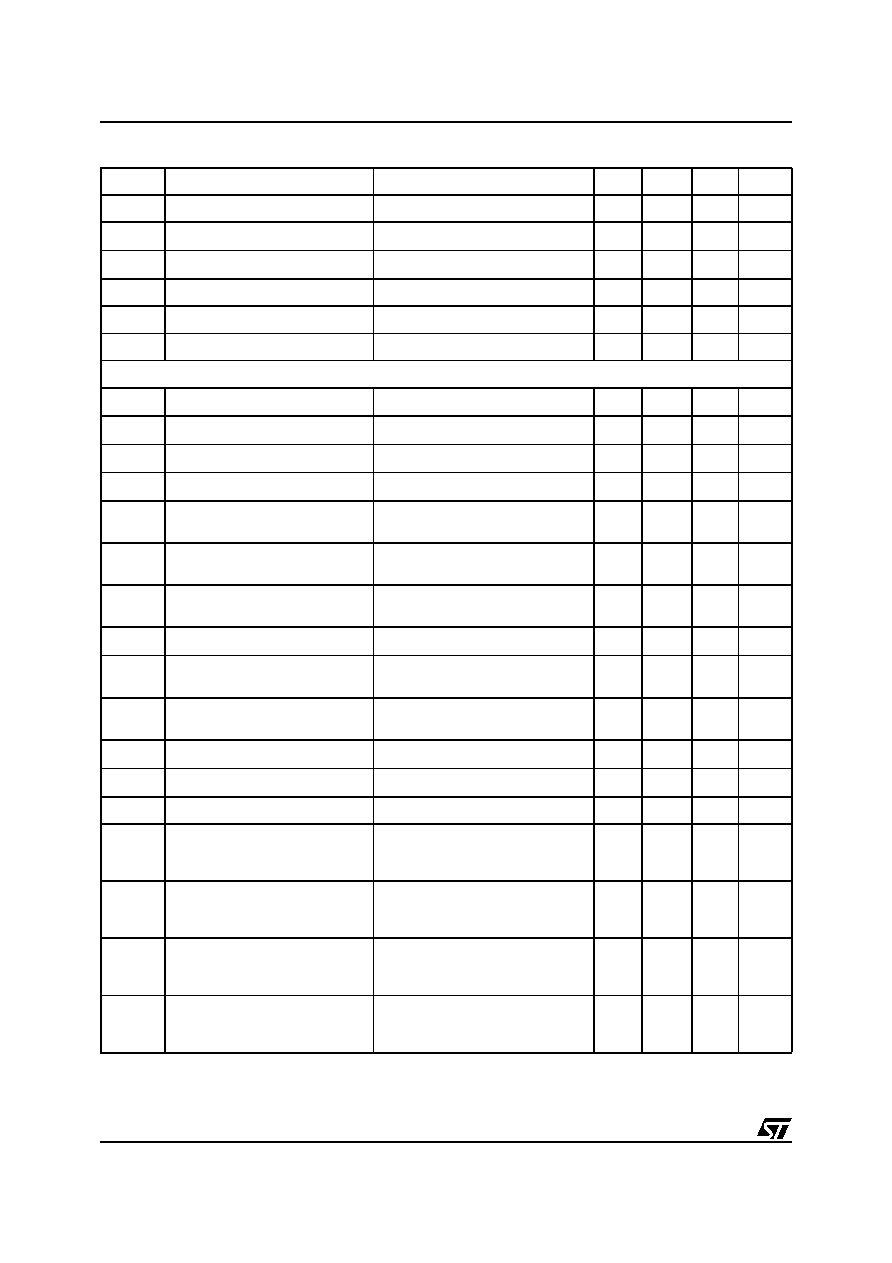
STA575
6/20
EN
Noise at Output bridge pins
f = 20Hz to 20KHz; Rg = 50
12
µ
V
Z
br_in
Input impedance
100
140
180
K
R
dson
Output power Rdson
I
O
= 1A
200
400
m
OLG
Open Loop Voltage Gain
100
dB
GB
Unity Gain Bandwidth
1.4
MHz
SR
Slew Rate
8
V/
µ
s
PROTECTION
V
stby
Stby voltage range
0
0.8
V
V
mute
Mute voltage range
1.6
2.5
V
V
play
Play voltage range
4
5
V
T
h1
First Over temperature threshold
130
∞C
T
h2
Second Over temperature
threshold
150
∞C
Unbal.
Ground
Upper Unbalancing ground
threshold
Referred to (CD
+
- CD
-
)/2
5
V
Unbal.
Ground
Lower Unbalancing ground
threshold
Referred to (CD
+
- CD
-
)/2
-5
V
UV
th
Under voltage threshold
|Vs+| + |Vs-|
18
20
22
V
P
d_reg.
Power dissipation threshold for
system regulation
I
prot
= 50
µ
A; @ Vds = 10V
26
32
39
W
P
d_max
Switch off power dissipation
threshold
@ Vds = 10V
60
W
I
prot
Protection current slope
for Pd > Pd
reg
400
µ
A/W
I
lct
Limiting Current threshold
6.3
7
7.5
A
I+Vs
Positive supply current
Stby (Vstby/mute pin = 0V)
Mute (Vstby/mute pin = 2.5V)
Play (Vstby/mute pin = 5V no signal)
20
20
5
35
35
7
50
50
mA
mA
mA
I-Vs
Negative supply current
Stby (Vstby/mute pin = 0V)
Mute (Vstby/mute pin = 2.5V)
Play (Vstby/mute pin = 5V no signal)
20
20
5
35
35
7
50
50
mA
mA
mA
ICD+
Positive traking rail supply current
Stby (Vstby/mute pin = 0V)
Mute (Vstby/mute pin = 2.5V)
Play (Vstby/mute pin = 5V no signal)
50
60
60
100
110
110
200
180
180
µ
A
mA
mA
ICD-
Negative traking rail supply current Stby (Vstby/mute pin = 0V)
Mute (Vstby/mute pin = 2.5V)
Play (Vstby/mute pin = 5V no signal)
50
60
60
100
110
110
200
180
180
µ
A
mA
mA
Symbol
Parameter
Test Condition
Min.
Typ.
Max.
Unit
ELECTRICAL CHARACTERISTCS (continued)

7/20
STA575
FUNCTIONAL DESCRIPTION
The circuit contains all the blocks to build a stereo amplifier. Each single channel is based on the Output Bridge
Power Amplifier, and its protection circuit. Moreover, the compression function and a signal rectifier are added
to complete the circuit.
The operation modes are driven by The Turn-on/off sequence block. In fact the IC can be set in three states by
the Stby/mute pin:
Standby ( V
pin
< 0.8V), Mute (1.6V < V
pin
< 2.5V), and Play (V
pin
> 4V).
In the Standby mode all the circuits involved in the signal path are in off condition, instead
in Mute mode the circuits are biased but the Speakers Outputs are forced to ground potential.
These voltages can be get by the external RC network connected to Stby/Mute pin.
The same block is used to force quickly the I.C. In standby mode or in mute mode when the I.C. dangerous
condition has been detected. The RC network in these cases is used to delay the Normal operation restore.
The protection of the I.C. are implemented by the Over Temperature, Unbalance Ground, Output Short circuit,
Under voltage, and output transistor Power sensing as shown in the following table:
Table 1. Protection Implementation
See the POWER PROTECTION paragraph for the details
Compression
An other important function implemented, to avoid high power dissipation and clipping distortion, is the Com-
pression of the signal input. In fact the preamplifier stage performs a voltage gain equal to 5, fixed by Ri and Rr
external resistor, but in case of high input signal or low power supply voltage, its gain could be reduced of 26dB.
This function is obtained with a feedback type compressor that , in practice, reduces the impedance of the ex-
ternal feedback network. The behavior of compression it's internally fixed but depends from the Audio input volt-
age signal level, and from the Threshold voltage applied to the Threshold pin. The attack and release time are
programmable by the external RC network connected to the Att_Rel pins.
The constraints of the circuit in the typical application are the following:
Vthreshold range
= -5 to 0
Vin peak max
= 8V
Vout peak max
= 10V
Fault Type
Condition
Protection strategy
Action time
Release time
Chip Over
temperature
Tj > 130 ∞C
Mute
Fast
Slow Related to
Turn_on sequence
Chip Over
temperature
Tj > 150 ∞C
Standby
Fast
Slow, Related to
Turn_on sequence
Unbalancing
Ground
|Vgnd| > ((CD+) -
(CD-))/2 + 5V
Standby
Fast
Slow, Related to
Turn_on sequence
Short circuit
Iout > 7A
Standby
Fast
Slow, related to
Turn_on sequence
Under Voltage
|Vs+| + |Vs-|< 20V
Standby
Fast
Slow, related to
Turn_on sequence
Extra power
dissipation
at output transistor
Pd tr. > 32W
Reducing DIGITAL
CONVERTER output
voltage.
Related to the
DIGITAL
CONVERTER
Related to the
DIGITAL
CONVERTER
Maximum power
dissipation
at output transistor
Pd tr. > 60W
Standby
Fast
Slow, related to
Turn_on sequence
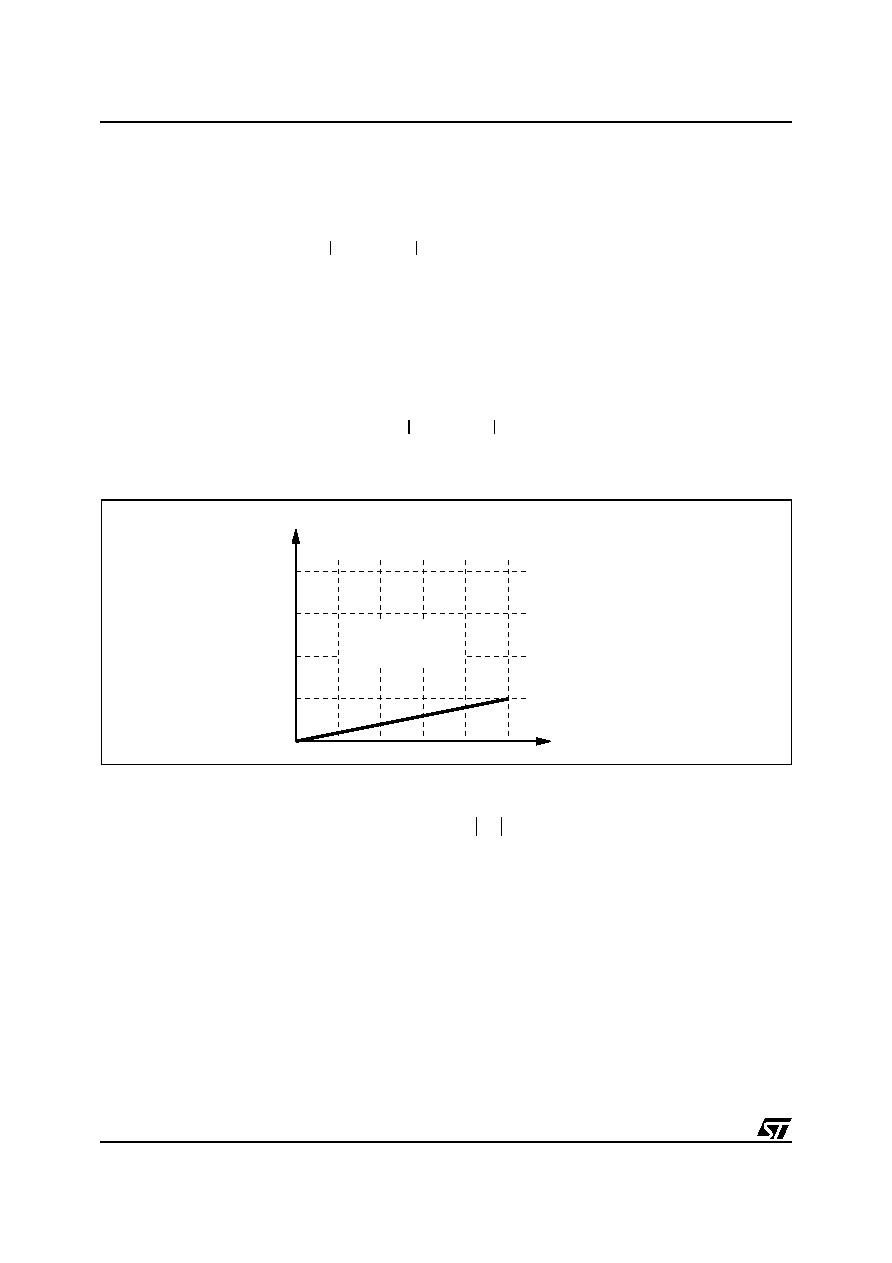
STA575
8/20
Gain without compression (G)
= 5
Max Attenuation ratio
= 26 dB
The following graph gives the representation of the Compressor activation status related to the Vthreshold and
the input voltage. The delimitation line between the two fields, compression or not, is expressed by the formula :
Where G is the preamplifier gain without compression.
In the compression region the gain of the preamplifier will be reduced
(G = 2∑Vthreshold/Vin) to maintain at steady state the output voltage equal 2*|Vthreshold| .
Instead in the other region the compressor will be off (G = 5).
The delimitation line between the two fields can be related to the output voltage of the preamplifier: in this case
the formula is :
Figure 1. Compressor activation field
The relative attenuation introduced by the variable gain cell is the following :
The total gain of the stage will be:
Gdb = 20log5 + Attenuation
The maximum input swing is related to the value of input resistor, to guarantee that the input current remain
under Iin_Max value (1 mA).
2
Vth resho ld
200 mV
+
(
)
G
--------------------------------------------------------------------------
V
out
2
Vthre sho ld
200m V
+
(
)
=
1
2
4
6
8
2
3
4
5
G = 5
|Vthreshold|
V
IN
PEAK
COMPRESSION
G < 5
D01AU1264
Atten uati on
20
2
5
---
log
V
th
200 m V
+
(
)
V
in_peak
------------------------------------------
=
R
i
V
in_peak
I
in_max
----------------------
>
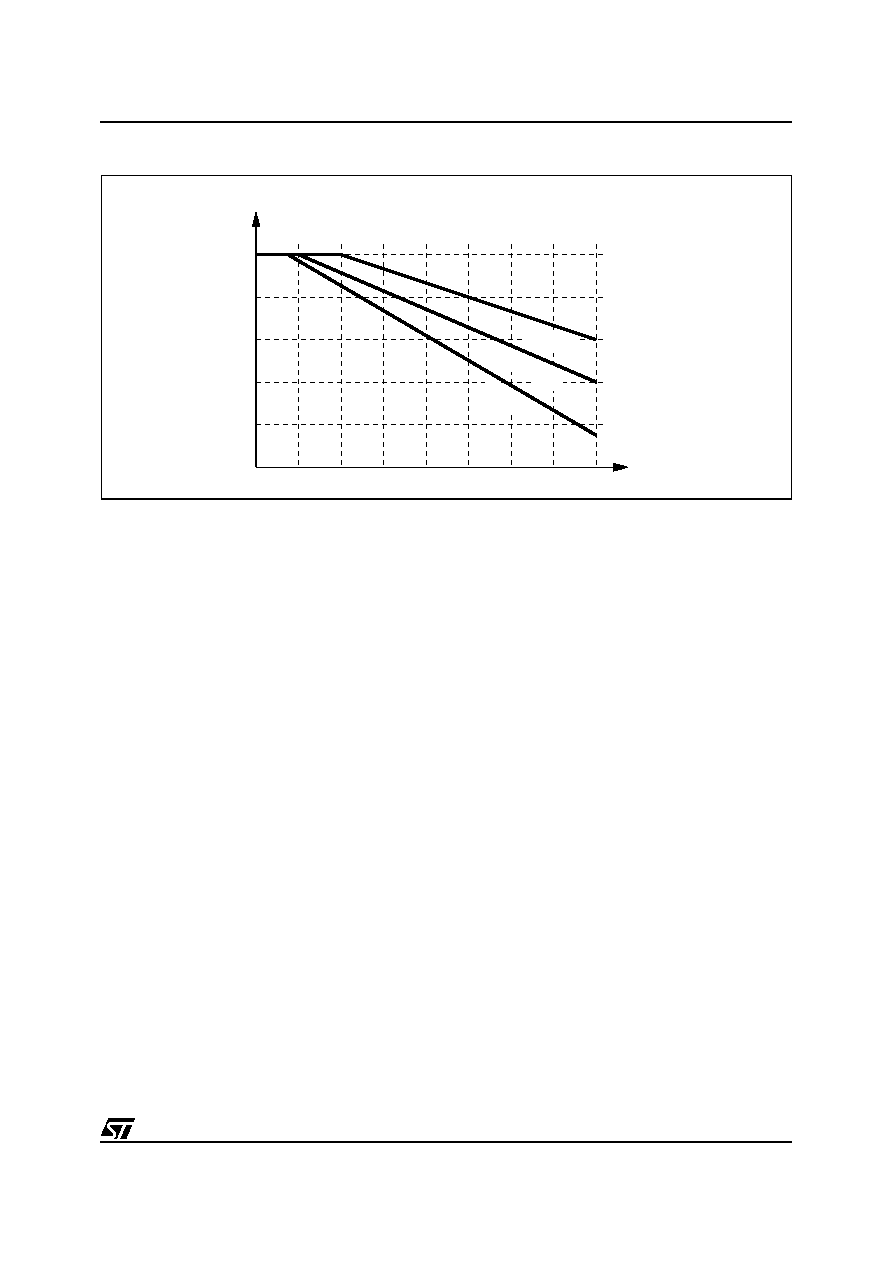
9/20
STA575
Figure 2. Compressor attenuation vs. input amplitude
ABSOLUTE VALUE BLOCK
The absolute value block rectifies the signal after the compression to extract the control voltage for the external
digital converter. The output voltage swing is internally limited, the gain is internally fixed to 14.
The input impedance of the rectifier is very high , to allow the appropriate filtering of the audio signal before the
rectification (between Out_pre and Trk pins).
OUTPUT BRIDGE
The Output bridge amplifier makes the single-ended to Differential conversion of the Audio signal using two
power amplifiers, one in non-inverting configuration with gain equal to 2 and the other in inverting configuration
with unity gain. To guarantee the high input impedance at the input pins, Pwr_Inp1 and Pwr_Inp2, the second
amplifier stages are driven by the output of the first stages respectively.
POWER PROTECTION
To protect the output transistors of the power bridge a power detector is implemented (fig 3).
The current flowing in the power bridge and trough the series resistor Rsense is measured reading the voltage
drop between CD+1 and CD+. In the same time the voltage drop on the relevant power (Vds) is internally mea-
sured. These two voltages are converted in current and multiplied: the resulting current , Ipd, is proportional to
the instantaneous dissipated power on the relevant output transistor. The current Ipd is compared with the ref-
erence current Ipda, if bigger (dissipated power > 32W) a current, Iprot, is supplied to the Protection pin. The
aim of the current Iprot is to reduce the reference voltage for the digital converter supplying the power stage of
the chip, and than to reduce the dissipated power. The response time of the system must be less than 200
µ
Sec
to have an effective protection. As further protection, when Ipd reaches an higher threshold (when the dissipated
value is higher then 60W) the chip is shut down, forcing low the Stby/Mute pin, and the turn on sequence is
restarted.
1
-24
-18
-12
-6
0
2
3
4
5
6
7
8
|Vinpk|
Attenuation(dB)
D01AU1265
|Vth=1|
|Vth=2.5|
|Vth=5|

STA575
10/20
Figure 3. Power Protection Block Diagram
In fig. 3 there is the power protection strategy pictures. Under the curve of the 32W power, the chip is in normal
operation, over 60W the chip is forced in Standby. This last status would be reached if the digital converter does
not respond quikly enough reducing the stress to less than 60W.
The fig.4 gives the protection current, Iprot, behavior. The current sourced by the pin Prot follows the formula:
for P
d
< P
d_av_th
the I
prot
= 0
Independently of the output voltage, the chip is also shut down in the folowing conditions:
When the currentthrough the sensing resistor, R
sense
, reaches 7A (Voltage drop (CD+) - (CD+1) = 700mV).
When the average junction temperature of the chip reaches 150∞C.
When the ground potential differ from more than 5V from the half of the power supply voltage, ((CD+)-(CD-))/2
When the sum of the supply voltage
|
Vs+
| +
|Vs-| <20V
The output bridge is muted when the average junction temperature reaches 130∞C.
X
V/I
ILOAD
I_PD
R
SENSE
MULTIPLIER
ILIM
CURRENT COMP
CURRENT COMP
OC1
PDP1
IPROT
TO TURN-ON/OFF
SEQUENCE
TO TURN-ON/OFF
SEQUENCE
TO PROT PAD
D01AU1266
IPDP
IPDA
IPD
IPD
V/I
OPA
OUT1-
OUT1+
OPA
CD-
CD+
CD+1
I
pr ot
P
d
P
d_av _th
)
≠
(
5 10
4
≠
1.25V
------------------------------------------------------------------
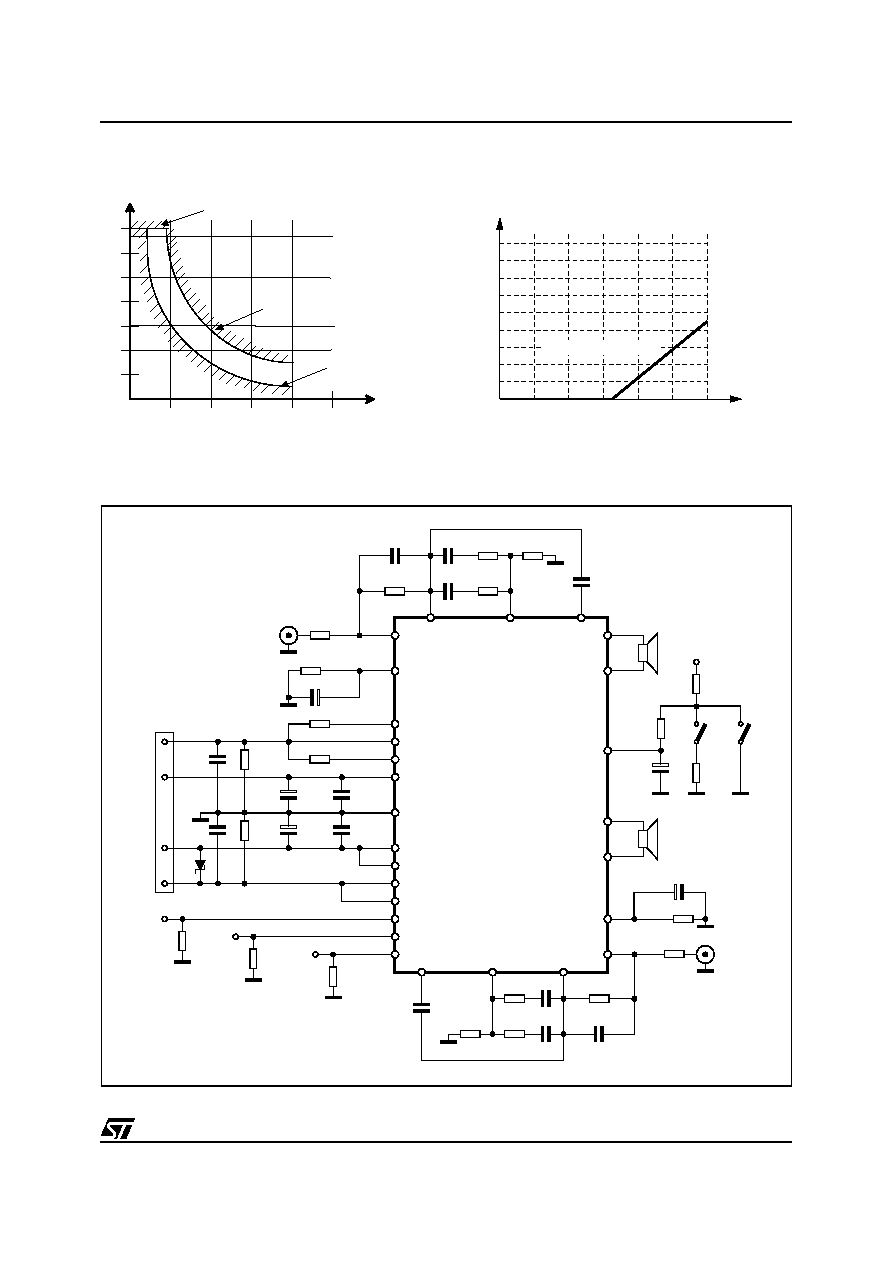
11/20
STA575
Figure 4. Power protection threshold
Figure 5. Protection current behaviour
2
4
10
20
30
40
50
Vds (V
Ids (
mA)
6
7
Pd_reg = 25W
Pd_M ax =
48W
Ilim = 6A
Standby
BucK
Limitation
Normal
Operation
10
10
20
20
30
40
50
60
Pd(W)
Iprot(mA)
D01AU1268
Iprot slope=0.4mA/W
Figure 6. Test Circuit for STA575 Stand-alone
INPUT1
IN_PRE1
OUT_PRE1
OUT1+
OUT1-
STBY/
MUTE
TRK_1
PWR_INP1
ATT_REL1
CD+1
CD+
CD+
CD+2
R1
R5
R16
R17
R24
C3
C12
C7
C17
C1
R14
R13
5V
R15
MUTE
STBY
C9
C5
R3
R9
R7
R11
INPUT2
IN_PRE2
OUT_PRE2
TRK_2
PWR_INP2
ATT_REL2
R2
R6
C4
C8
C16
C2
C6
R4
R10
R8
R12
+V
S
+V
S
-V
S
-V
S
-V
S
GND
R22
R20
C13
D1
C14
C15
C10
C11
CD-1
TRK-OUT
PROT
THRESH
PROT
THRESH
TRK-OUT
CD-2
CD-
R19
R18
OUT2+
OUT2-
D01AU1267
8
9
10
7
4
5
24
11
23
25
20
19
18
21
3
6
15
22
14
13
27
1
26
2
16
12
17

STA575
12/20
EXTERNAL COMPONENTS (refer to fig. 6)
Note: Vcontrol is the voltage at Att_Rel pin.
Name
Function
Value
Formula
Ri
R1 = R2
Input resistor
10K
(|G| = 5, Rr = 50K
)
Rr
R3 = R4
Feedback resistor
50K
(|G| = 5, Ri = 10K
Cac
C1 = C2
AC Decoupling capacitor
100nF
(fp = 16Hz,
Rac =100K
)
Cct
C3 = C4
Capacitor for the attack time
2.2
µ
F
(Tattack = 13mSec,
Vcontrol = 9V,
Ict = 1.5mA)
R5 = R6
Release constant time Resistor
470K
(
t
= 1 Sec. ,
Cct = 2.2
µ
F )
R7 = R8
Resistor for tracking input voltage
filter
10K
R9 = R10
Resistor for tracking input voltage
filter
56K
R11 = R12
Resistor for tracking input voltage
filter
10K
C5 = C6
Capacitor for Tracking input
voltage filter
1nF
C7 = C8
Dc decoupling capacitor
1
µ
F
R13
Bias Resistor for Stby/Mute
function
10K
R14
Stby/Mute constant time resistor
30K
R15
Mute resistor
30K
C9
Capacitor for Stby/Mute resistor
2.2
µ
F
R16 = R17
Sensing resistor for SOA detector
100m
5% 4W
R18
Conversion resistor for threshold
voltage
100K
C10 = C11
Power supply filter capacitor
100nF
R22 = R24
Centering resistor
400
,
1W
C12 = C13
Tracking rail power supply filter
680nF
R19
Protection
1K
R20
TRK_out
40K
C14 = C15
Power supply filter capacitor
470
µ
F
,
63V
C16 = C17
Feedback capacitor
100pF
D1
Schottky diode
SB360
R
i
Rr
G
-------
=
Rr
G
Rr
=
Cac
1
2
fp Rac
---------------------------------
=
Cct
attack
Ict
Vcontrol
-------------------------
=
Rct
Cct
---------
=
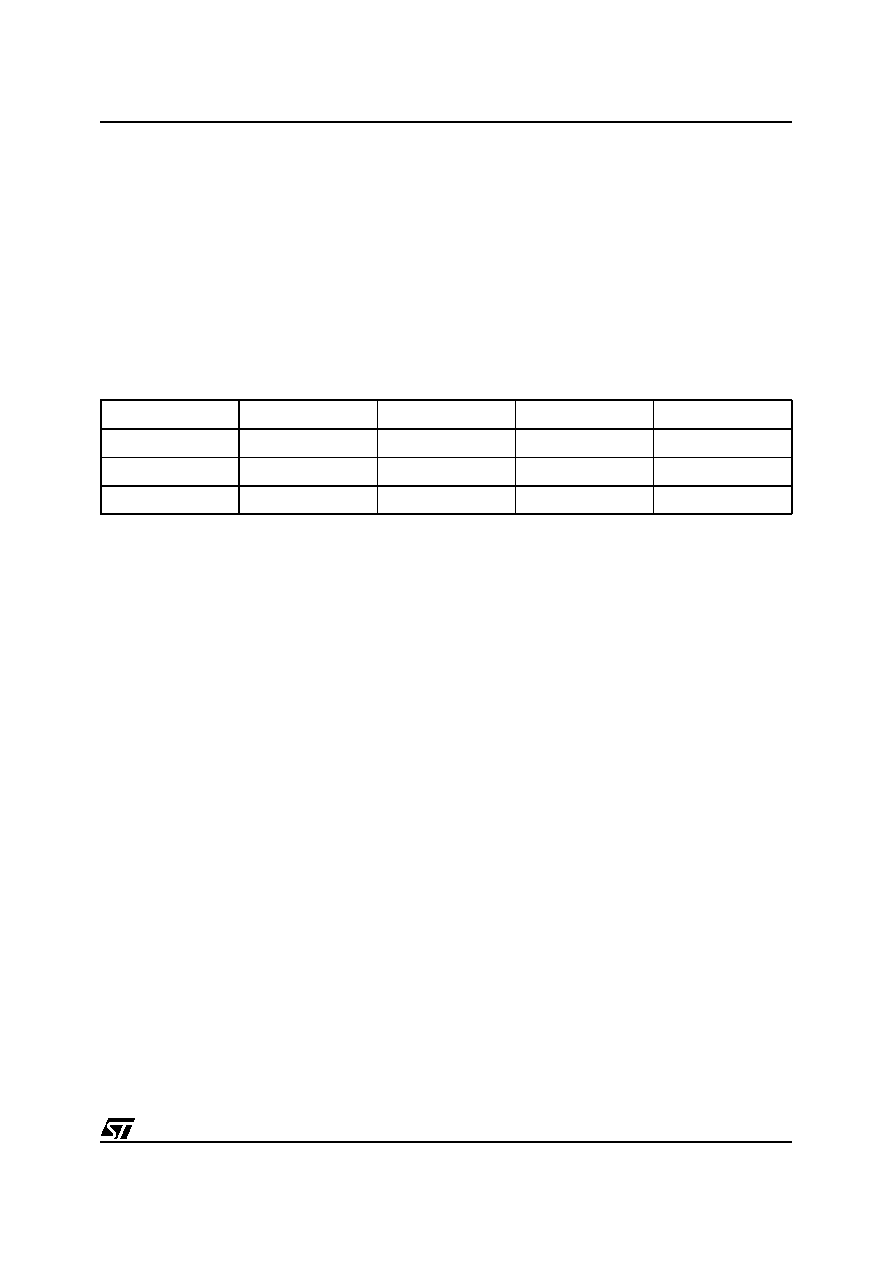
13/20
STA575
APPLICATION HINTS (refer to fig. 6)
PREAMPLIFIER AND COMPRESSOR
In the test circuit showed in figure 6, R
1
/R
3
(or R
2
/R
4
) ratio fix the gain of the preamplifier.
If the input signal is very low, is possible to increase the gain fixing the product Vin
G = cost.
In that case is possible to increase G decreasing R
1,2
from 10K
until 2K
without relevant effetcs on the cir-
cuitbehavior and remaining in the operating range I
in_max
= V
in_max
/R
1(2)
,<1mA.
So it is possible to increase the preamplifier gain until 25.
If no compression is present (equivalnt compressor Gm=0), the effects are:
≠ The output voltage offset increase
≠ The SNR decrease
The following table shows these variations:
R
3(4)
= 50K
and all the other external components are the same
Attenuation = 0 dB
If the compression is active the circuit behaviour is the same.
It"s also possible to eliminate the compressor. In this case the ATT_REL (1,2) pin must be connected to gnd.
STBY-MUTE CIRCUIT
In the suggested application circuit (figure 6), the resistor for Standby/Mute function (R
13
) is connected between
the Standby/Mute switches and 5V Supply.
It is possible to connect the resistor to another Supply Voltage level V
L
, but in that case also the resistor value
(R
13,14
) must be changed according to the following formula (fixing V
STBY/MUTE
= 2.5V and R
15
= 10K
):
HEADROOM
In the suggested application circuit the supply voltage to obtain 75W (Power Output) on 8
(R
load
)
is:
It is also possible to increase the system's efficiency forcing the headroom to follow the output signal (variable
drop insteadof a constant drop).
In that case:
R
1,2
V
IN MAX
G
V
OFFSET
EN
10K
8V
5
15mV
10
µ
V
5K
4V
10
30mV
13
µ
V
2K
1.6V
25
75mV
20
µ
V
R
13
4 V
L
10
≠
(
)
K
=
R
14
4 V
L
10
+
(
)
K
=
V
suppl y
V
I
L M AX
,
R
D S on
+
=
V
sup ply
V
I
L
V
( )
R
D S on
+
=
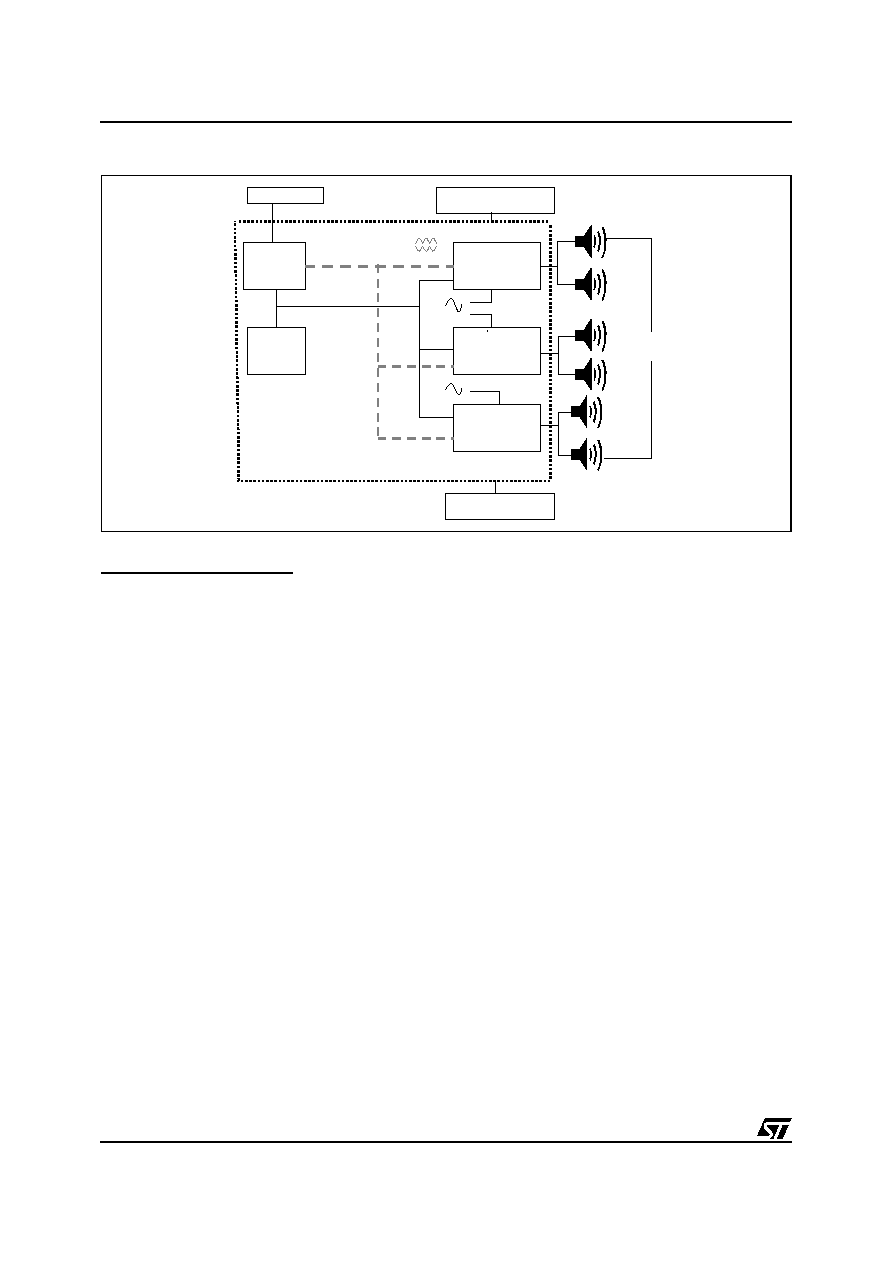
STA575
14/20
Figure 7. BASHÆ module SAM351 5.1 with 2 x STA575 (see application note AN1656)
Power - On-Off sequences:
In order to avoid damages to the SAM261 board it is important to follow these sequences:
At Power-On apply in the first the Auxiliary Power Supply (±24V) and after the Main Power Supply
(+50V), in this condition the system is in "Mute state" and it can move in "play state" with the switch present
on the pcb.
At Power-Off is better to bring the SAM module in "Mute state" and after that to follow this order: switch-
off the Main Supply Voltage (+50V) and subsequently the Auxiliary Power Supply. (±24V).
System Description & Operating Rules
SAM351 is a BASHÆ 5.1 amplifier ( 6 x 100W) implementation utilizing the STA575 Integrated Circuit.
Specifically designed for multi-channel implementation in DVD - HTIB systems, Multi-Media systems, AV Re-
ceivers.
SAM351 is dimensioned to provide the maximum Output Power (THD=10 %) on two channels and instanta-
neously and 1/3 max Pout on the remaining Outputs, or 1/8 of max Pout continuous; this rule is important to
define the main Power Supply size (+50V).
Buck Regulator Description
The function of the buck regulator is to convert efficiently an input voltage to a lower voltage by adjusting the
ratio of the switching transistor's on-time to off-time. The resulting waveform is averaged by the output filter to
recover an analog signal.
In the BASH amplifier this output is in effect split in half by centering it on the audio ground to provide CD+ and
CD- rails.
To avoid the need for a high side driver for the transistor switch in the buck regulator the buck circuit recom-
mended has the switch in the return path. Hence the gate drive circuit (part of the STPB01) is referenced to the
negative return of the main supply that provides power for the buck regulator.
STA575
2 x100Watts
STA575
2 x 100Watts
Buck
Regulator
+50VDC
6 Ohm Loads
Audio
Inputs
STABP01
Controller
Dynamic Power Supply
(CD+ & CD
-)
Signal Power Supply
+/-24V DC / 50
mA
+/-24V DC / 50
mA
Signal Power Supply
Lines of Controls
STA575
STA575
2 x 100Watts
2 x 100Watts
Audio
Input
STA575
2 x100Watts
STA575
2 x 100Watts
Buck
Regulator
+50VDC
6 Ohm Loads
Audio
Inputs
STABP01
Controller
Dynamic Power Supply
(CD+ & CD
-)
Signal Power Supply
+/-24V DC / 50
mA
+/-24V DC / 50
mA
Signal Power Supply
Lines of Controls
STA575
STA575
2 x 100Watts
2 x 100Watts
Audio
Input

15/20
STA575
Interfacing STA575 to STPB01 (Feedback circuit)
This circuit produces a control signal current that is fed back to the STPB01 digital controller. The network used
in this example compares the track signal (STA575 track out) to a fixed ratio of buck regulator's output (CD+)
using a transistor. This method is effective because the controller's reference is the negative of the main DC
supply, which is not referenced to audio ground.
The tracking signal is generated inside the STA575 (track out) by taking the absolute value of the pre-amp's
output. The outputs of each channel and of each STA575 are then tied together in a diode-oring arrangement.
This means that the highest of any given output is the output that determines the tracking signal.
The absolute value circuit inside the STA575 has gain. This makes it possible to use an RC network and a re-
sistor divider to create a phase shift in the tracking signal at higher frequencies. This is also useful in optimizing
the alignment of the buck regulator's output with the output signal of the bridge amplifier at high frequency
This circuit first converts the buck switch current to a peak voltage. The control current is then converted to a
voltage (using a resistor) and added to the peak voltage. By doing this, the buck is better able to maintain the
desired headroom over a wide load range and output level.
Centering Network for CD+ & CD- Rails
The power rail of a bridge amplifier has no current flowing through the ground node, as the load is not connected
to ground. However there are several different small sources of dynamic and continuos ground currents flowing
from either CD+ or CD- to support the function of various things such as the control signal to the STABP01 con-
troller.
The centering network prevents these currents from shifting the CD+/- rails away from center i.e. away from a
symmetric split of the buck's output about ground. This is critical, even a small centering error requires an in-
crease in headroom which results in a significant drop in output losses. In its simplest form the centering network
could be a resistor divider from CD+ to CD- with its center tied to ground.
As long as the impedance is low enough (for example 200 ohms) this will swamp the smaller offset currents. It
is helpful to put this kind of passive network on the board with the STA575 devices to help when testing this
board on its own.
Power Amplifier Heatsink requirements
The heatsink requirements are dependent on several design goals. However there are two common references:
Pink noise at 1/8 of full power, all channels loaded. This would approximate a system with all channels repro-
ducing music at full volume with clipping occurring only occasionally. The second would be full power at 1kHz
for 5 minutes after a one hour pre-soak at 1/8 power.
The worse of these two is the full power test. A conservative approach is to assume that the heatsink would
come to thermal equilibrium after 5 minutes. Thus the Rth of the heatsink can be determined by:
For example in the STA575 the Rth jc is 1∞C / W. R case-to-heatsink with grease is about 0.5∞C / W. The max-
imum operating junction temperature is 130∞C, which for margin should be derated to 120∞C
Buck Regulator Heatsink
The Buck regulator heatsink can be designed in a similar manner and does not change by varying power supply.
In general the efficiency will be in the order of 85%. The thermal impedances from the junction(s) to the heatsink
may be lower and the maximum operating temperature will be higher.
Usually either the sub or the remaining channels are tested at full power. The result is that usually the Buck
heatsink is about º the size of the linear heatsink, but this can be strongly affected by the design.
R
th heatsink
T
jm ax
T
am b
≠
P
d
----------------------------------
R
th j ca se
≠
R
th c as e to heatsink
≠
≠
=
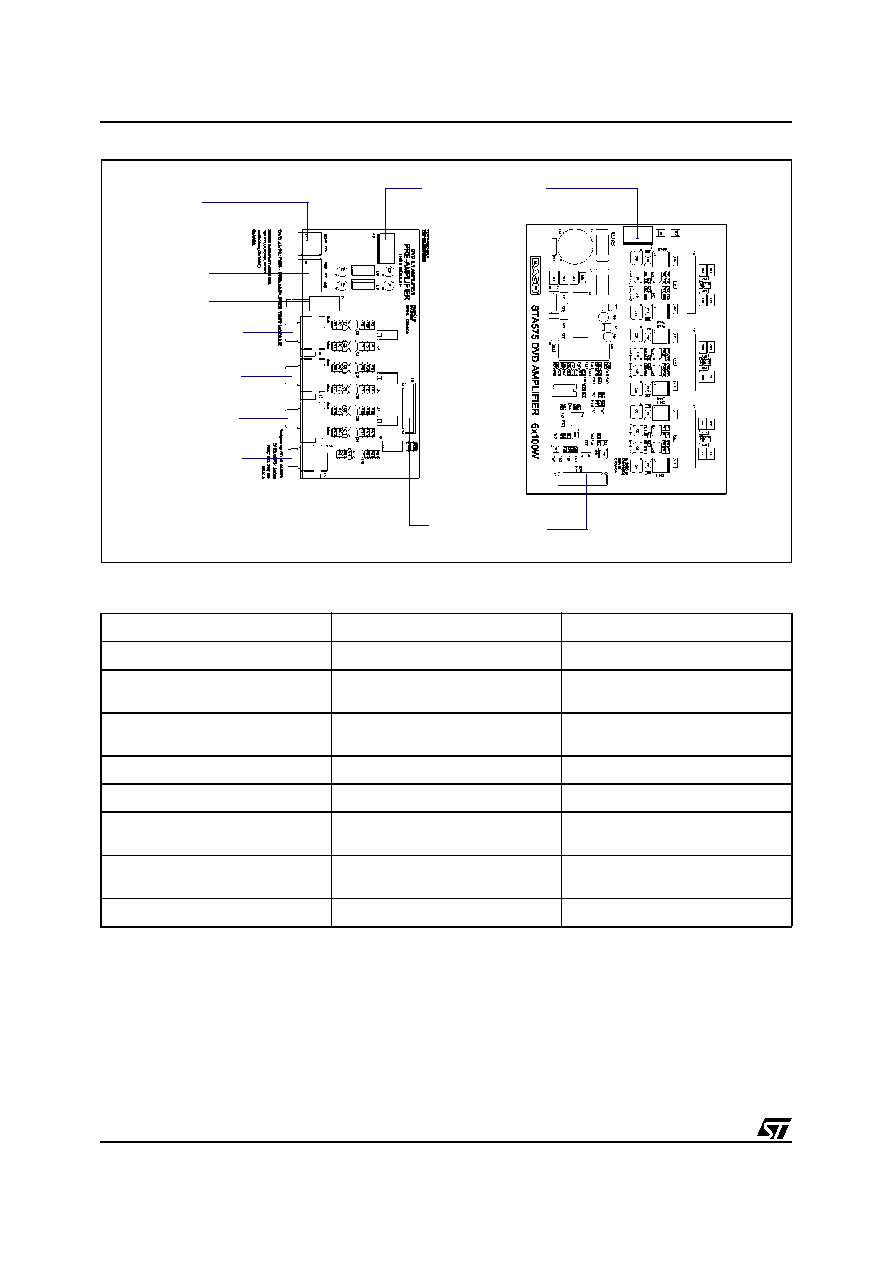
STA575
16/20
Figure 8. PCBs AND COMPONENTS LAYOUT
SAM261 Specification
Parameter
Rating
Notes
Output Power
100Watts @10% - 6
see graphs
THD + N
< 0.05% @ 40 Watts
< 0.05% @ 75 Watts
Measured @ 1KHZ
SNR
-104 dB (relative to full power)
-113 dB (A-weighted)
Sensitivity
1 .3VRMS
Amplifier
Crosstalk
-76dB (relative to10W)
1KHz 8 Ohms,
Main Power Supply Inputs
60Volts @ 4 Amps
Maximum Voltage is 60V
Minimum Voltage is 50V
Aux Power Supply Inputs
+ 24 Volts @ 100mA
-24 Volts @ 100mA
Vs supply
Input Board
1 .3VRMS
Suplied to facilitate testing
4 Pin Harness
Power Supply Connections
9 Pin Harness
Audio Connections
Channel 1 and 2
50 VDC
Input
+/-24 VDC
Input
Mute
Channel 3 and 4
Channel 5
Channel 6

17/20
STA575
Figure 9. THD +N FR Channel
Figure 10. THD + N Frequency
Figure 11. Residual Noise vs. Frequency
Figure 12. Frequency Response
Audio Precision
0.01
10
0.02
0.05
0.1
0.2
0.5
1
2
5
%
10
140
20
30
40
50
60
70
80
90
100
110
120
130
W
Audio Precision
0.01
10
0.02
0.05
0.1
0.2
0.5
1
2
5
%
10
140
20
30
40
50
60
70
80
90
100
110
120
130
W
Audio Precision
0.01
10
0.02
0.05
0.1
0.2
0.5
1
2
5
%
20
20k
50
100
200
500
1k
2k
5k
10k
Hz
Audio Precision
0.01
10
0.02
0.05
0.1
0.2
0.5
1
2
5
%
20
20k
50
100
200
500
1k
2k
5k
10k
Hz
Pout = 80W
Pout = 30W
Pout = 5W
Audio Precision
-160
+0
-140
-120
-100
-80
-60
-40
-20
dBr
20
20k
50
100
200
500
1k
2k
5k
10k
Hz
Audio Precision
-160
+0
-140
-120
-100
-80
-60
-40
-20
dBr
20
20k
50
100
200
500
1k
2k
5k
10k
Hz
Audio Precision
+0
+40
+2
+4
+6
+8
+10
+12
+14
+16
+18
+20
+22
+24
+26
+28
+30
+32
+34
+36
+38
dBr
10
40k
20
50
100
200
500
1k
2k
5k
10k
20k
Hz
Audio Precision
+0
+40
+2
+4
+6
+8
+10
+12
+14
+16
+18
+20
+22
+24
+26
+28
+30
+32
+34
+36
+38
dBr
10
40k
20
50
100
200
500
1k
2k
5k
10k
20k
Hz
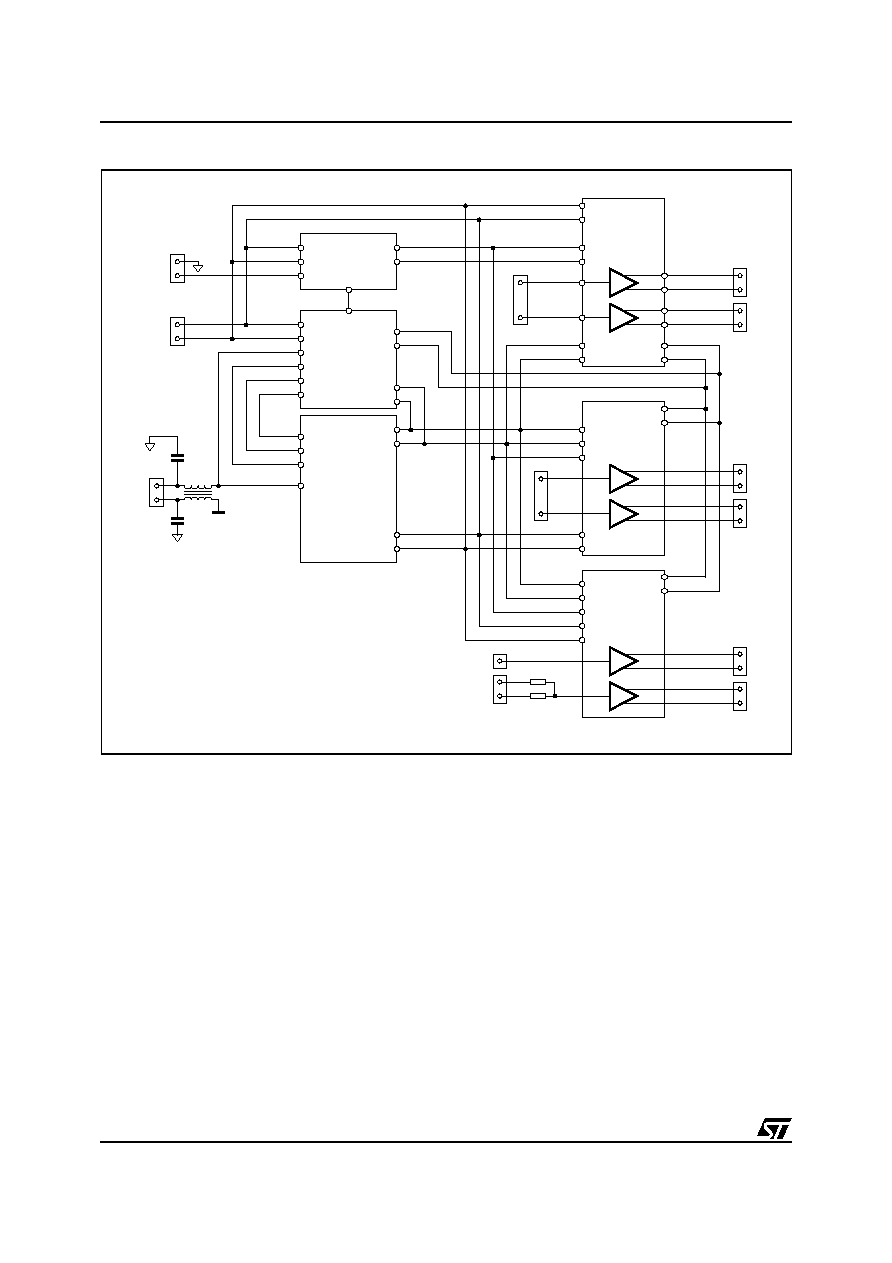
STA575
18/20
Figure 13. APPICATION BLOCK DIAGRAM
15
µ
H
L2
MUTE CONTROL &
THRESHOLD
REFERENCE
MUTE-BUCK
MUTE-BUCK
+V
S
MUTE
MUTE
MUTE
OUT1+
OUT1-
OUT2+
OUT2-
OUT3+
OUT3-
OUT4+
OUT4-
IN1
IN2
IN3
IN4
-V
S
MUTE
MUTE
BUCK CONTROLLER
300W BUCK
+V
S
-V
S
+V
S
-V
S
DC++
DC++
GATE-DRIVE
I-SENSE
PWM-SPLY
PWM-SPLY
GATE-DRIVE
I-SENSE
1800pF
1800pF
TRACK
PROT
CD-
CD-
CD+
CD+
CD-
CD+
CD-
CD+
TRACK
TRACK
PROT
PROT
THRESH-REF
THRESH-REF
-V
S
+V
S
-V
S
-V
S
+V
S
+V
S
RED
RED
WHITE
RED
WHITE
GND
DC++
J1
J2
J1
J3
J4
J2
STA575
2 CHANNELS
STA575
2 CHANNELS
MUTE-LIN
OUT5+
OUT0-
OUT6+
OUT8-
IN5
IN6
CD-
CD+
TRACK
PROT
R77
R78
-V
S
+V
S
J5
J6
J4
J3
STA575
2 CHANNELS
D02AU1454
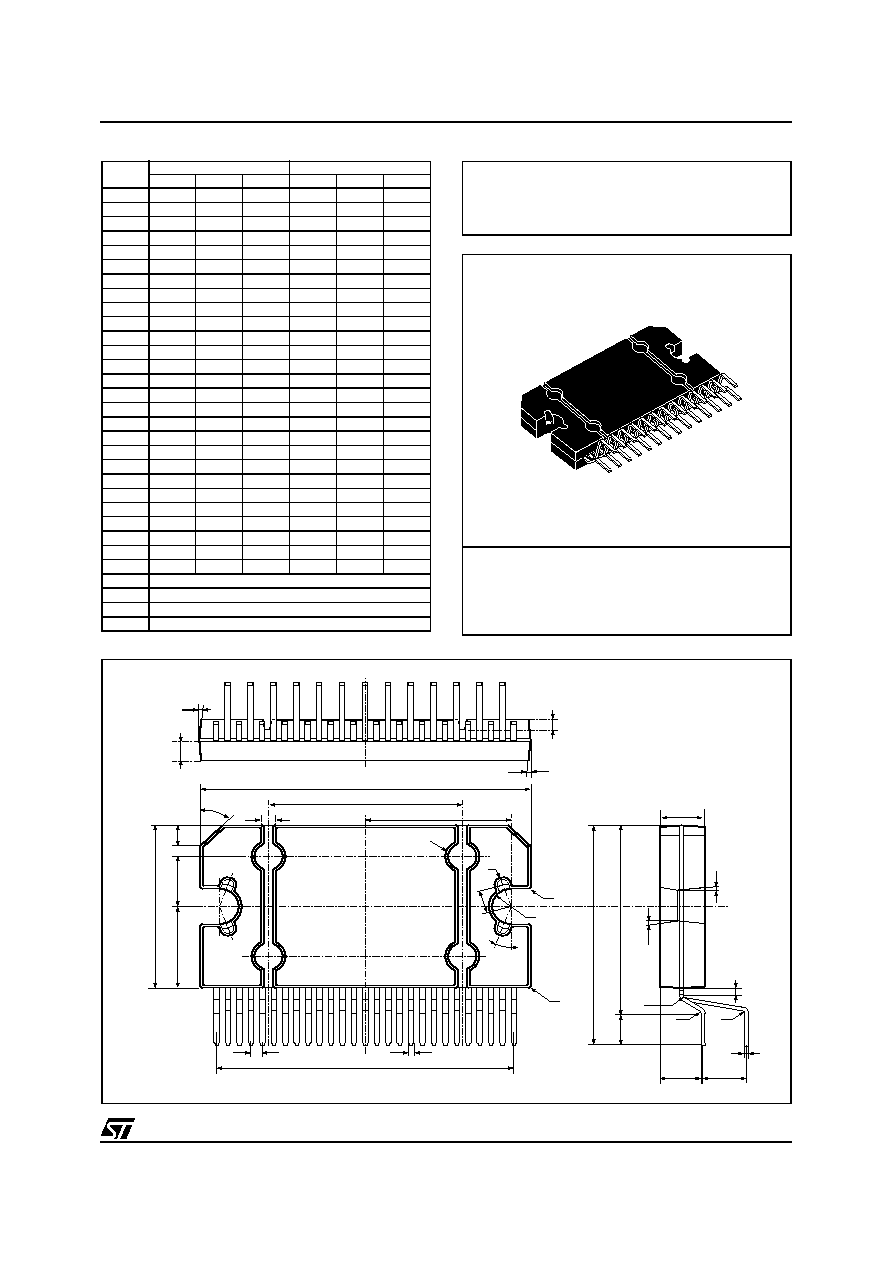
19/20
STA575
OUTLINE AND
MECHANICAL DATA
DIM.
mm
inch
MIN.
TYP.
MAX.
MIN.
TYP.
MAX.
A
4.45
4.50
4.65
0.175
0.177
0.183
B
1.80
1.90
2.00
0.070
0.074
0.079
C
1.40
0.055
D
0.75
0.90
1.05
0.029
0.035
0.041
E
0.37
0.39
0.42
0.014
0.015
0.016
F (1)
0.57
0.022
G
0.80
1.00
1.20
0.031
0.040
0.047
G1
25.75
26.00
26.25
1.014
1.023
1.033
H (2)
28.90
29.23
29.30
1.139
1.150
1.153
H1
17.00
0.669
H2
12.80
0.503
H3
0.80
0.031
L (2)
22.07
22.47
22.87
0.869
0.884
0.904
L1
18.57
18.97
19.37
0.731
0.747
0.762
L2 (2)
15.50
15.70
15.90
0.610
0.618
0.626
L3
7.70
7.85
7.95
0.303
0.309
0.313
L4
5
0.197
L5
3.5
0.138
M
3.70
4.00
4.30
0.145
0.157
0.169
M1
3.60
4.00
4.40
0.142
0.157
0.173
N
2.20
0.086
O
2
0.079
R
1.70
0.067
R1
0.5
0.02
R2
0.3
0.12
R3
1.25
0.049
R4
0.50
0.019
V
5∞ (Typ.)
V1
3∞ (Typ.)
V2
20∞ (Typ.)
V3
45∞ (Typ.)
(1): dam-bar protusion not included
(2): molding protusion included
Flexiwatt27 (vertical)
H3
R4
G
V
V
G1
L2
H1
H
F
M1
L
FLEX27ME
V3
O
L3
L4
H2
R3
N
V2
R
R2
R2
C
B
L1
M
R1
L5
R1
R1
E
D
A
V1
V1
7139011
Pin 1

Information furnished is believed to be accurate and reliable. However, STMicroelectronics assumes no responsibility for the consequences
of use of such information nor for any infringement of patents or other rights of third parties which may result from its use. No license is granted
by implication or otherwise under any patent or patent rights of STMicroelectronics. Specifications mentioned in this publication are subject
to change without notice. This publication supersedes and replaces all information previously supplied. STMicroelectronics products are not
authorized for use as critical components in life support devices or systems without express written approval of STMicroelectronics.
The ST logo is a registered trademark of STMicroelectronics
Æ
2003 STMicroelectronics - All Rights Reserved
is the registered trademark and patented technology of INDIGO manufacturing inc.
STMicroelectronics GROUP OF COMPANIES
Australia - Brazil - Canada - China - Finland - France - Germany - Hong Kong - India - Israel - Italy - Japan -Malaysia - Malta - Morocco -
Singapore - Spain - Sweden - Switzerland - United Kingdom - United States.
http://www.st.com
20/20
STA575



















